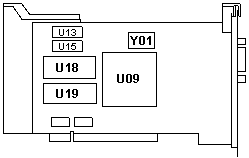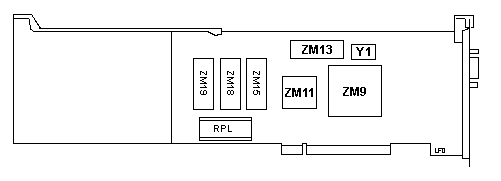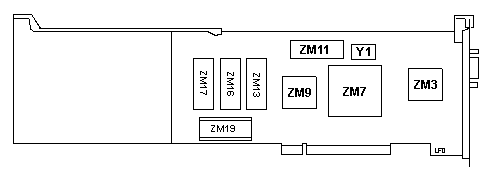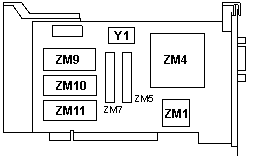|
IBM Token-Ring Network 16/4 Adapter/A
TRM164.EXE
Drivers/Diagnostic/Option disk v2.0
Many adapters use "E001" adf. But there are different versions of the
adfs to choose from.
@E001.ADF -
IBM Token-Ring Network 16/4 Adapter/A (Tropic based)
There are a few differences between cards that I haven't
a explanaition for. If you have a better answer (or just an answer) send
it to ME.
Short 16/4 Token Ring Adapter
(74F9415 or 74F9321)
02G1394ESD vs.
50G6144ESD
Tokin'
Madness
16/4 Long Token Ring
Adapter
53F7748
16F1144
Short 4MB Token Ring Adapter
25F7540
Identifying the Tropic
Chipset
OEM Tropic chipset list
Registers on Screen?
ADF Settings
Primary
or Alternate Adapter
Adapter Data
Rate
ROM Address
Range
RAM Size and Address
Range
Interrupt Level
Memory
Adapter fails to insert
on ring
Promiscuous Copy and Promiscuous
Mode
Trace and Performance Adapter
Hack
Short 16/4 Token
Ring Adapter (74F9415 or 74F9321)

U09 02G1394ESD
U13 Toshiba TC55329J-25
U15 Toshiba TC55329J-25
U18 74F9686 Even, 1991
U19 74F9687 Odd, 1991
Y01 32.000MHz
U09 50G6144ESD
U13 Toshiba TC55329J-25
U15 Toshiba TC55329J-25
U18 74F9686 Even, 1991
U19 74F9687 Odd, 1991
-OR-
U18 60G2484 Even, 1991 or
1993
U19 60G2483 Odd, 1991 or 1993
Y01 32.000MHz
Most short 16/4 have the RPL-code integrated in the ROM-code - the 4Mb/s
and the long 16/4 adapters have a separate ROM for it - and the chip needed
to be purchased separately.
02G1394ESD vs. 50G6144ESD
Win95 can detect the difference between the two. Install a 16/4
with main chip 02G1394ESD. W95 is happy. But install a 50G6144ESD, up comes
the familiar "Your IBM 16/4 Token Ring is not set up correctly..."
W95 will continue to load and the TR works on an 8228.
Must be the chipset is close enough to complain about, but also close enough
to work.
Tokin' Madness
I got a few more short 16/4s. I noticed some (to me) interesting
factoids. The 02G1394ESD chipset cards' bios
chips do not change their dates. The 50G6144ESD
have two sets of bios dates, some are 1990 and some are 1993. I have one
50G6144ESD
card that has the bios chips from the 02G1394ESD
card.
Postulate- The 02G1394ESD
chip is OK, but the 50G6144ESD had a problem,
they issued a new bios for it. They even tried the bios off the 02G1394ESD.
I don't have a large enough population to derive a high correlation, but...
My wild SWAG is as good as yours...
16/4 Long Token
Ring Adapter 53F7748 / 93F0331

ZM9 51F1439ESD/63F7704ESD
ZM11 25F7335
ZM13,15 M5M5256BP-10L
or CXK58257AP-70L |
ZM18 25F9524
ZM19 25F9523
Y1 32.0000 MHz
RPL RPL |
16/4 Long Token
Ring Adapter 16F1144

ZM3 64D7274ESD
ZM7 02F8442ESD
ZM9 25F7335
ZM11 NEC D43256AC-19LL
ZM13 NEC D43256AC-19LL
ZM16 25F9532
ZM17 25F9531
ZM19 RPL Chip
Y1 32MHz
Differences between the 53F and 16F adapters are the addition
of a 64D7274ESD and different ROM (25F9532 and 25F9531). They are basically
the same - however the one with the 64D7274 at ZM3 is the later revision.
This chip contains the output drivers and some "corporate logic", which
was the 2 14-pin ICs on the elder version (ZM1 & ZM4).
The P/N for the RPL-ROM is 25F8923 by the way.
4MB Token Ring Adapter
25F7540

With the infamous Tropic chipset
ZM1 25F7335
ZM4 51F1439ESD
ZM5 Mitsubishi M5M5179P-55
ZM7 Mitsubishi M5M5179P-55
ZM9 25F9158, Even
ZM10 25F9157, Odd
ZM11 BIOS (RPL)
Y1 32MHz
Identifying the
Tropic Chipset
Hi Louis !
>Is the 51F1439ESD and 25F7355 the Tropic chipset?
If the card-ID = E001 (or E000 for the 4Mb/s) then - Yes. This
chipset is also used by all E000 / E001 compatible cards from Madge, Compex,
Hypertech, Kingston etc. pp. ... some cards use different card-ID however.
IBM came "out of the TROPICs" for MCA with the LanStreamers
(MC16 - 8FA4/ MC32 - 8FA0 & 8FA2). The TR Server Busmaster adapter
(8FC8) bases mainly on the Tropic architecture as far as I know.
OEM TROPIC chipset
list
Listed below is the TROPIC chip set that IBM licensed from National
Semiconductor.
DP8025 Token Ring Interface Controller
DP802511 TROPIC RAM Relocation Register Decoder
DP802512 Upper Memory Decoder
DP802513 Memory MEMCS-16 Signal Decoder
DP802514 TROPIC REEF
DP802515 TROPIC PELE
The DP802514 and DP802515 are Microcode ROMs for the TROPIC Token-Ring
Network Controllers and they feature an interface that is compatible
to DP8025 Interface Controller to allow direct interfacing without the
use of GLUE logic.
Peter sez:
If you look at the Madge "True Blue" 16/4 card you will
find the same silver capped NatSemi chip there. Card has ID E001 - and
works with the same "Tropic" drivers under Linux. NatSemi was a second
source manufacturer of the Tropic chipset for quite some time. Other customers
were e.g. Hypertec in Australia, which used IBM and NatSemi chips. At least
I have seen Hypertech E001 cards with both sorts of chips.
In the pictures database there is a Madge TR with the
NatSemi and a Hypertech (long card) with the IBM chip. Later -on the Auto-TR
16/4- IBM switched to an all-plastic chip.
David Beem sez:
My "Networking the Desktop, Cabling, Configuration,
and Communications" (Deni Conner/Mark Anderson, Academic Press, 1995) explains
the various TR chipsets in a couple of paragraphs. The NS chip is refered
to in the second:
"Texas Instruments (TI) announced an agreement with
IBM to develop a
token ring chipset called the TMS380 based on the IBM token-ring
specification. This chipset had technological and performance advantages
over the IBM chipset that allowed increased data buffers for data transfer
and also allowed direct memory access (DMA) transfers, in which an
onboard controller managed access to memory. Later, TI enhanced the TMS380
chipset to accomodate 16Mbps token-ring networks, resulting in the TMS380C16.
Recently [to when the book was written], TI announced an advanced token-ring
chipset using the TMS380C26 chipset, which integrates more functionality
than the previous two.
While the TI chipset is 100-percent compatible with
the IEEE 802.5 and
802.2 token-ring specifications, it is not 100-percent compatible with
IBM's LLC protocol implementation. As a result, IBM developed the Token-Ring
Protocol Interface Controller (TROPIC) chipset for third-party vendor use,
ensuring register-level compatibility for all IBM applications. Marketed
by National Semiconductors under licence from IBM, TROPIC manufacturers
include vendors such as Madge Networks, Proteon, Thomas-Conrad Corp., Cabletron
Systems, and 3Com.....".
Registers on Screen?
This is new- I got a few lines in the upper left eigth of the
screen. They were registers- AX, BX... They didn't change... There was
a top line with an ET that actually counted the seconds... Up to 26 by
the time I gave up on rebooting...
Peter-
That's a TR adapter trying to RPL..... check startup sequence.
ADF Settings
Primary
or Alternate Adapter
Up to two Token-Ring Network adapters may be installed
in a computer, either as Primary, (accessed at 0A20 through 0A23),
or Alternate (accessed at 0A24 through 0A27). If one Token-Ring Network
adapter is installed, it may be either Primary or Alternate. If two are
installed, one must be Primary and the other Alternate.
Adapter Data Rate
The data rate must be set to the same rate (4 or 16 Mbps)
as the Token-Ring Network to which you are connecting the adapter. The
4MB TR card doesn't have a choice, it's 4MB only. If you attach a 4MB adapter
to a 16MB network, the network will automatically drop to the 4MB/sec rate.
In short, don't mix speeds!
ROM Address Range
There are 12 possible 8K blocks of memory that can be
assigned for accessing the ROM area of the Token-Ring Network adapter.
The preferred ROM address is CC000-CDFFF.
RAM Size and Address Range
There are 30 possible blocks of memory that can
be assigned for accessing the RAM located on the 16/4 Token-Ring Network
adapter. The preferred RAM Size and Address Range for the adapter, which
allows RAM Paging, is: 16 KB / D8000-DBFFF.
Interrupt Level
This Token-Ring Network adapter can operate on one of
four interrupt levels: 2, 3, 10, or 11. The preferred interrupt level
is 2.
Memory
It has 64 KB of random access memory (RAM), of which 63.5 KB
are available for use by an application program and 512 bytes are reserved.
Adapter fails
to insert on ring
A Token-Ring adapter may fail to insert on the ring due
to adapter congestion. Adapters entering the ring send a request to the
Ring Parameter Server (RPS) address to learn ring parameters, such as ring
number. If the RPS exists on this ring, which is usually the case
only if the ring is bridged to another segment, this RPS request frame
returns to the originating station with the Address Recognized Indicator
(ARI) set; ARI set informs the inserting station that the RPS
exists on this ring and that the station should wait for the RPS response
before completing its insertion on the ring. The RPS returns its
response to the inserting station as a normal Token-Ring frame. If
the inserting station's adapter has begun to experience significant congestion
by this time, it may not be able to process the frame. The adapter
driver then will stop the adapter's insertion because the adapter
was unable to process the RPS response.
This problem is more likely to occur on multistation access
units (MAUs) with electronic relays that do not disturb the
ring during an adapter insertion; the adapter may have to wait seven
seconds to participate in the neighbor notification process. In units
without electronic relays, the relay disturbance causes the
active monitor to start a new neighbor notification process and the adapter
does not have to wait as long to insert. The longer insertion time
increases the probability that the adapter will become congested.
The 802.5 Standards Committee recommends that the RPS
send two frames to the adapter: one normal frame and one frame with the
express, buffer-bits set. The inserting adapter will then copy the
express frame into its express buffer. This information is documented
in the errata sheets from the 802.5 Standards meeting V.
Promiscuous Copy
and Promiscuous Mode
NOT supported on the 16/4 Token-Ring Network Adapter/A
with RPL, 16/4 Token-Ring Network Adapter/A or the Token-Ring Network Adapter/A
Trace and Performance Adapter
I thought these were special adapters. Turns out that
it's just a special BIOS for the short and long 16/4 TR adapters...
From Peter
You need the two .BIN files for burning two Eproms. These replace
the two Eproms on the 16/4 card. The "analyzer" machine needs to run a
generic DOS with the modified adapter installed.
Then extract the TAP20.BIN ... at the C:/ Dos-prompt
type TAP ... then "Measure Ring Performance" - enter any file name for
storing the performance data, [ENTER], then select "Start measuring" from
the menu ... and if you did it all right you get a nice bar graph with
the TR network load. Mine never reaches values over 65% - even when I have
all workstations running and do large copy and backup jobs.
There are other functions as well. You could build
a "traffic matrix": simply spoken "who talks with whom ?" - the program
shows the burn-in adresses (these 12-digit codes burned in the adapter)
- here it pays to overwrite these internal adresses with own ones ... my
server for example has 4000 0001 CAFE (hex numbers only).
Or having a list which computer has which burn-in adress. WINIPCFG
(under 95/98) shows the burn-in adress, some cards have stickers at the
rear (LanStreamer, modern cards).
Hmmm....I am not quite sure at the moment if you need any of
the DOS LAN support drivers (DXMA0MOD.SYS / DXMC0MOD.SYS / DXMT0MOD.SYS)
in your CONFIG.SYS. My P70 has at least the DXMA0MOD.SYS ... but the TAP
opens and closes the adapter during operation.
3 files.
1. TAP20.ZIP (The software)
2. TAP164O.BIN (Odd Eprom, 27C256-20, Checksum 518E)
3. TAP164E.BIN (Even Eprom, 27C256-20 Checksum 9B14)
I tried them with the "long" 16/4 and the two short ones (with and w.o.
RPL). Currently they are running with a 93F0179 - which is the short 16/4
with RPL.
Feelin' like TAP Dancing?
If you have a eprom burner, send me a message for the BIN
files and TAP Program!
9595 Main
Page
|